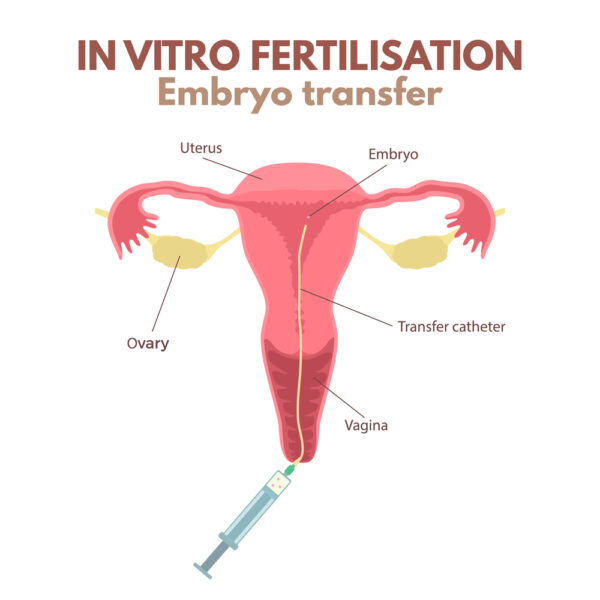How Many Embryo Transfer In IVF?

In the world of assisted reproductive technology, in vitro fertilization (IVF) is a beacon of hope for individuals and couples struggling with infertility. A critical stage of the IVF process is the embryo transfer, where the carefully developed embryos are placed into the woman’s uterus to initiate pregnancy. But how many embryos should be transferred? This decision holds great significance in determining the chances of a successful pregnancy while minimizing potential risks. In this comprehensive guide, we will explore the different aspects of embryo transfer in IVF, including the types of transfers, the choice between single and multiple embryo transfers, and what steps can be taken to enhance the chances of a successful outcome.
What is Embryo Transfer?
Embryo transfer is a pivotal step in IVF Treatment, where one or more embryos created through the fertilization of eggs and sperm are placed into the woman’s uterus with the hope of establishing a successful pregnancy.
When is Embryo Transfer Done in IVF?
In the process of IVF, the fertilized egg, also known as the embryo, is placed directly into the uterus to enhance the likelihood of successful implantation.
Typically, it takes approximately 6 to 10 days from the egg retrieval procedure for the embryo to successfully implant. The actual embryo transfer can occur within a window of two to five days following the egg retrieval. The specific timing depends on the developmental stage of the embryo at the time of transfer. Pregnancy results can be anticipated within a range of 10 to 12 days after the embryo transfer procedure.
Types of Embryo Transfer
There are several types of embryo transfer procedures used in IVF:
- Fresh Embryo Transfer: In this approach, embryos are transferred to the uterus shortly after fertilization and culturing, usually on day 3 or 5 post-fertilization.
- Frozen Embryo Transfer (FET): In FET, embryos are cryopreserved (frozen) after fertilization and transferred to the uterus at a later date, typically during a natural or medicated cycle.
- Blastocyst Embryo Transfer: Blastocyst transfer involves the transfer of embryos on day 5 or 6 after fertilization when they have reached the blastocyst stage of development.
- Cleavage Embryo Transfer: Cleavage stage transfer involves placing embryos into the uterus on day 2 or 3 after fertilization before they reach the blastocyst stage.
Single Embryo Transfer vs. Multiple Embryo Transfer
A significant decision in the IVF process is whether to opt for a single embryo transfer (SET) or a multiple embryo transfer (MET). Each choice carries its own set of advantages and considerations.
When to Opt for Single Embryo Transfer (SET)?
SET is recommended in various situations, including:
- Age: Younger women who are 38 year or younger with a higher chance of success may opt for SET to reduce the risk of multiple pregnancies.
- High-Quality Embryos: When high-quality embryos are available, transferring one may offer excellent chances of success.
- Previous Successful IVF: Couples who have previously achieved pregnancy with IVF may opt for SET to avoid the risks associated with multiple pregnancies.
- Medical Conditions: Women with medical conditions that make a multiple pregnancies high-risk may choose SET.
When to Opt for Multiple Embryo Transfer (MET)?
MET may be chosen in cases where:
- Advanced Maternal Age: Women of advanced age who are older than 38 years may have a lower chance of success, so transferring multiple embryos may enhance the likelihood of pregnancy.
- Lower-Quality Embryos: If the embryos are of lower quality, transferring more may increase the chances of a successful pregnancy.
- Previous Failed IVF: Couples who have experienced multiple failed IVF attempts may choose MET in hopes of improving their odds.
- Personal Preferences: Some individuals or couples may have personal preferences for multiple pregnancies.
How Long Does the Embryo Transfer Process Take?
The embryo transfer itself is a relatively quick procedure, often taking only 10 –15 minutes. It is performed in an outpatient setting and does not typically require anesthesia.
How Many Embryo Transfer In IVF?
The number of embryos to transfer is a critical decision influenced by factors like the woman’s age, the quality of the embryos, and the medical histories of the individuals involved. As a general guideline, most fertility clinics aim for a single embryo transfer to minimize the risk of multiple pregnancies, which can pose health risks to both the mother and the fetuses. However, the decision is highly individualized, and in some cases, transferring more than one embryo may be recommended.
What to Do After Embryo Transfer to Increase Success?
After the embryo transfer, there are several steps individuals can take to optimize their chances of a successful outcome:
- Rest and Recovery: Rest for a brief period after the procedure but resume normal activities the next day.
- Medications: Continue prescribed medications as directed by your fertility specialist.
- Stress Management: Minimize stress through relaxation techniques like meditation or gentle exercise.
- Healthy Lifestyle: Maintain a balanced diet, regular exercise, and avoid alcohol and tobacco.
- Stay Informed: Stay informed about the potential symptoms and signs of pregnancy, and communicate any concerns with your healthcare provider.
- Follow-Up: Attend follow-up appointments as scheduled to monitor progress and make any necessary adjustments to the treatment plan.
Dreaming of a Family?
Iris IVF Centre is Your Partner in Parenthood! Contact us today for a personalized consultation and begin your IVF journey!
Conclusion
In conclusion, embryo transfer is a crucial step in the IVF journey, and the number of embryos to transfer should be carefully considered based on individual circumstances. The goal is to achieve a healthy, successful pregnancy while minimizing the risks associated with multiple pregnancies. Couples should work closely with their fertility specialist to make informed decisions that align with their goals and unique medical history.


